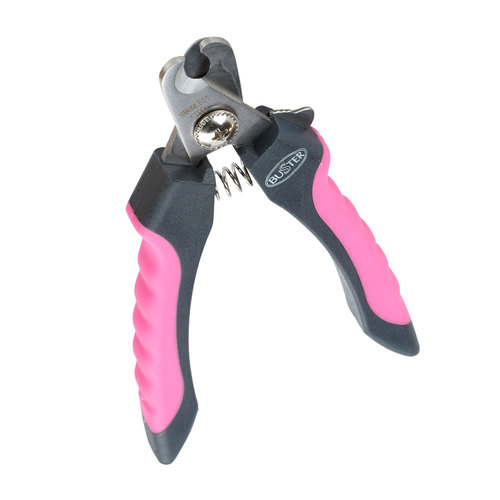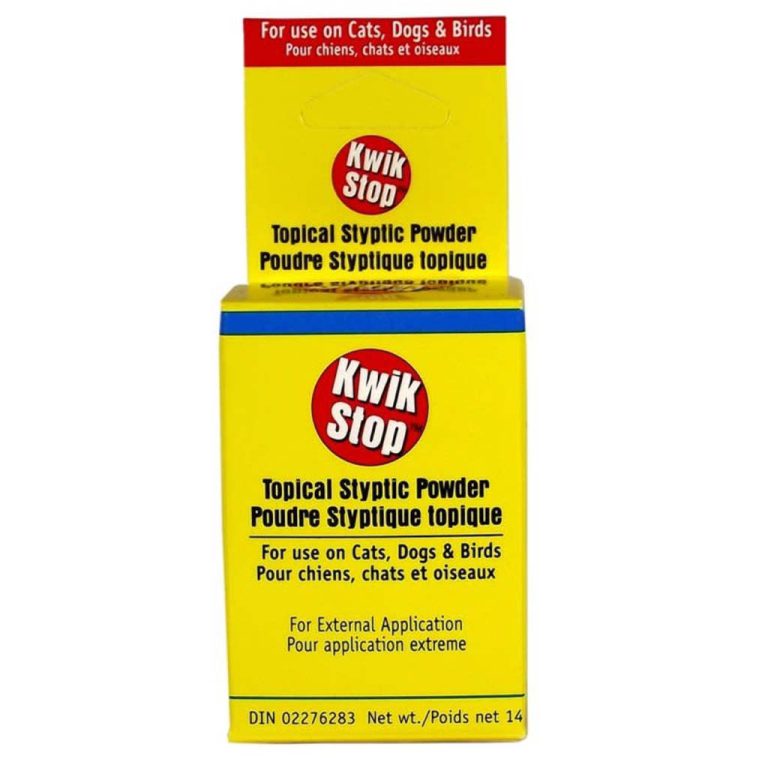Category: HEALTH
The Littermate Syndrome
Overview
- Puppies with littermate syndrome become highly dependent on one another.
- This can affect dogs of any breed and also unrelated puppies who are adopted and raised together.
- Signs can include excessive crying, whining, and destructive behavior when siblings are separated.
- Littermate syndrome can be difficult, due to the numerous behavioral issues that are involved.
- While raising sibling puppies successfully can be difficult, the key is to treat them as individuals.
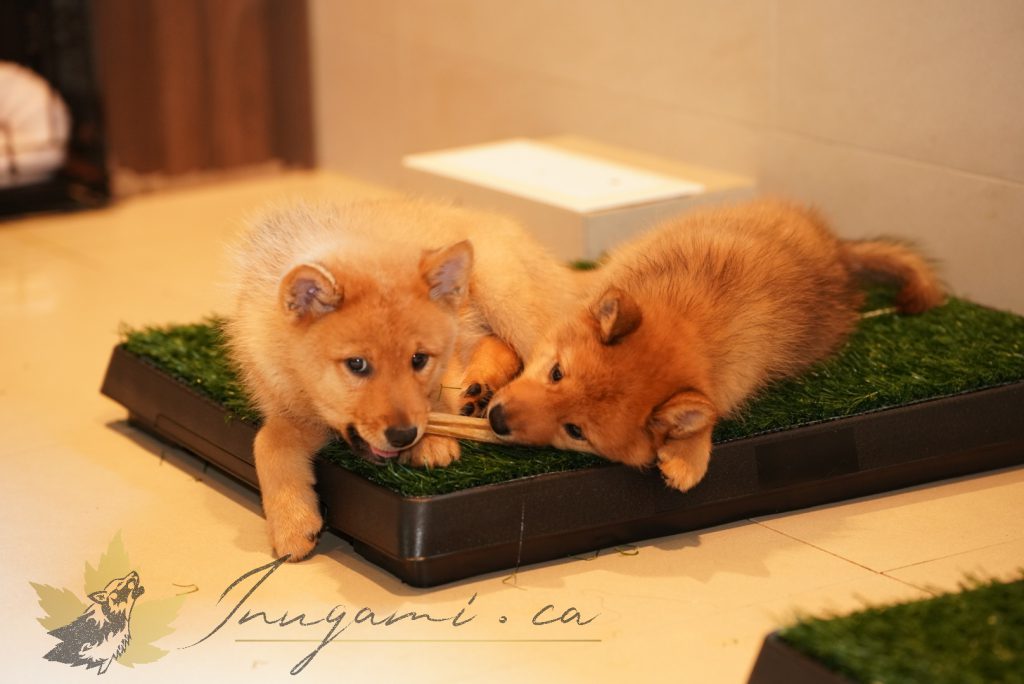
Many factors influence behavior, and not all siblings raised together will exhibit this problem, which is called “littermate syndrome.” In other words, it’s a risk, not a foregone conclusion.
That said, many dog behaviorists, trainers, breeders, and shelters actually discourage adopting siblings. Anecdotal evidence suggests that behavioral issues may arise during key development periods because the two puppies’ deep bond impedes their individual ability to absorb and grasp the nuances of human and canine communication. Since fear is the dog’s default reaction to odd or unfamiliar stimuli, this muddled understanding of the world around them can lead to impaired coping mechanisms later on.
What is Littermate Syndrome?
“Littermate syndrome in dogs occurs when two puppies from the same litter living together develop such a strong attachment to each other that it interferes with their ability to interact in a normal manner with other people, other dogs, or any situation where they are not together,” says Collier.
This happens because littermates bond so intensely to each other that they fail to develop connections with their human family. Puppies with littermate syndrome only interact with each other and become highly dependent on one another for a sense of safety and normalcy.
Littermate syndrome can affect dogs of any breed, and it may also affect unrelated puppies who are adopted at the same time and raised together.
Dunbar points out that raising littermates requires training two puppies, which is particularly challenging when they’re essentially wearing blinders to all but each other. “It’s more than twice the work; it’s exponential. The two combine to produce levels of energy that we can barely measure," he says. "Tension develops in training and compliance as they squeeze the human out of the relationship. They’re always living with an enormous distraction: each other.”
Signs of Littermate Syndrome in Dogs
At first, puppies with littermate syndrome may seem like they’re acting out or in need of obedience training. However, when dogs experience littermate syndrome, these behaviors are linked to their relationship to their littermate.
Signs of littermate syndrome in dogs can include excessive crying, whining, and destructive behavior when siblings are separated from one another, as well as a lack of interest in playing or interacting with other people or pets in your household, says Collier.
Here are a few signs of littermate syndrome in puppies and dogs to look out for:
Fear of unfamiliar people, things, places, or noises. Puppies may avoid interactions with new people, dogs, or things; become very still and quiet when you approach them; or bark, growl, and snap when presented with new things or situations.
High anxiety when separated from the other pup. Puppies may whine, bark, pace, pant, or exhibit destructive behavior when they’re separated from their littermate.
Unwillingness to eat alone. Dogs experiencing littermate syndrome may only want to eat if their sibling is present.
Unwillingness to engage with people or toys when alone. As previously mentioned, littermate syndrome sometimes causes puppies to focus on the other puppy rather than the humans in the home. Puppies who are only willing to play in pairs may be exhibiting signs.
Difficulty with basic training. Training two puppies from the same litter may take longer than expected because puppies are so distracted by one another.
If you’re considering adopting two puppies at the same time, it’s important to consider the challenges that may come along with this decision, so that you can devote the time and energy to positive-reinforcement training.
How to Prevent Littermate Syndrome in Dogs
The easiest way to prevent littermate syndrome in puppies is to not adopt two pups at the same time, says Graddy.
However, preventing littermate syndrome can also be as simple as treating siblings as individuals from the moment they enter your home, says Collier. Make sure that your pups are getting plenty of exercise and interaction with you, your family, and others—not just alone time with each other, she says.
Another solution if you must have two puppies? Consider adopting unrelated puppies a few weeks or months apart.
Funny note : littermate syndrome doesn’t seem to afflict kittens. In fact, many veterinarians recommend adopting kittens in pairs. They can be much easier to raise with a playmate and two is not much more work than one.
Challenges of Littermate Syndrome in Dogs
Littermate syndrome can be difficult for pet parents to deal with, due to the numerous behavioral issues that are involved. Pet parents may notice these problems early on, though they may not arise until pups reach adolescence, notes Graddy.
Most commonly, puppies develop separation anxiety due to hyper-attachment. Because puppies with littermate syndrome dominate each other’s attention, they may fail to learn how to communicate, play, and socialize with other dogs. Over time, this can result in fear and aggression when they’re exposed to other dogs.
Because dogs with littermate syndrome are so focused on each other, they may also bond less with their pet parents. In turn, they could fail to learn and develop appropriate social interactions with humans, too.
Littermate syndrome makes training two puppies from the same litter especially difficult. Because littermates are so focused on each other, it’s difficult for pet parents to get their attention. As a result, teaching puppies even basic skills becomes a greater challenge than it would be if you were training them one at a time.
In the worst-case scenario, littermates may attack each other. Aggression between housemates is more common between littermates adopted together than unrelated dogs adopted at different times.
For these reasons, adopting two puppies at a time may mean more work, not less, for most pet parents.

Health & Breeding Statistics
Breed at Glance
The national dog of Finland, Finnish Spitz is a model for success in terms of execution of a breed-specific breeding strategy. Known as Suomenpystykorva in Finland, the Finnish Spitz is one of the healthiest dog breeds, and the Finns want to keep it as such for future generations. The dogs can be expected to live to > 11 to 15 years of age. The Finnish breed association estimates that the worldwide living population of the Finnish Spitz is somewhere in the range of 13,000 – 15,000 dogs. The breed is relatively rare outside of Finland and neighboring Scandinavian countries.
Goal-oriented breeding of the Finnish Spitz, started officially in 1892, when the first breed standard of a “Finnish barking bird dog” was written. The breeding goal was to develop a skillful dog, who barks at birds perched in trees, and who at the same time is also a beautiful yard dog.
A Finnish Spitz dog uses its voice to indicate the location of game. Today the dogs are used to hunt forest game birds, but also to some extent serve as an elk-hunting dog as well as to hunt small game and retrieve birds shot into the water.
The most important breeding goals along with good health are to retain the breed’s current bird-barking characteristics without forgetting its diverse potential as a versatile hunting dog. The Finnish Spitz is a designated hunting dog, so its mental make-up and other properties must be up to this task. Today behaviour of the Finnish Spitz dogs corresponds quite well to the breed standard. Finnish Spitz can nowadays be an excellent pet for the whole family.
Key Health Conditions - The Basics
Finnish Spitz is a relatively healthy dog breed. Key inherited health conditions include patella luxation, missing teeth, eye diseases (cataracts and PHTVL/PHPV) and epilepsy. The breed has also had problems with reproduction.
Epilepsy has been the focus of significant attention in this breed and the effort has yielded significant results.
(See more under the Health and Breeding section.)
Finnish Spitz - Breed Specific Breeding Strategies
Due to the concentration of Finnish Spitz primarily in Finland and Scandinavia we will focus on presentation of health and breeding strategies utilized in that region of the world. There is longstanding cooperation and sharing of resources and health information for breeds between Kennel and Breed Clubs that are members of the Nordic Kennel Union. Health screening tests as well as other important breed management considerations are outlined in the Finnish JTO and PEVISA and the Swedish and Norwegian RAS documents.
What are the RAS, JTO and PEVISA?
A RAS or JTO is a breed-specific breeding strategy based on evidence and information gathered from a range of sources. Hence, the breeding plan should be tailored to the conditions of the individual breed and consider all aspects relevant in the breeding goal for that breed, i.e., physical and mental health, working traits as well as population structure and genetic variation. The documents contain the history of the breeds, a description of the present situation, and goals and strategies for the future. The idea is that the document should constitute an overall plan for the breed and act as a guideline to breeders.
PEVISA is Finnish and short for “perinnöllisten vikojen ja sairauksien vastustamisohjelma”, which translates as “programme against hereditary defects and diseases”. Aimed at breeders and breed associations, it includes breeding dog health requirements for breed-specific registration conditions. Also use of inbreeding and popular sires can be limited with the program. The PEVISA regulations vary from breed to breed, and are usually updated every five years for each breed.
Among other things, these programmes aim to ensure that hereditary diseases commonly occurring in a breed are taken under control and that their spread is prevented. Breed associations apply for a PEVISA programme to be authorised for their breed and they are responsible for monitoring the programme’s impact. Breed associations and their subordinate clubs are similarly responsible for steering the breeding in their respective breeds as well as for their breed’s JTO/RAS.
Health Screening Tests for Finnish Spitz
Maintaining the good health of the breed is the most important breeding goal. Individuals [dogs] transmitting hereditary problems should be culled from breeding without reducing the gene pool too much.
Health Tests/Screening: Finland, Sweden & Norway
Veterinary patella examination – Finland mandatory (PEVISA) and Norway recommended for Finnish Spitz breeding dogs in order to get their offspring registered or approved by the breed club. In Norway the diagnosis has to be 0 (normal); in Finland the grade I (almost normal) is allowed. If one parent has a grade I luxation, the other one should have grade 0 (normal patellas). Sweden recommends patella examination be done.
Notes: Patella luxation: Susceptibility increases with a build, in which the long bones of the hind leg are convoluted respective to each other, the trochlear groove is shallow and the entire knee angle is too open. The structure of the hind leg is a hereditary trait, which can be influenced through breeding.
Prevalence notes: Of the dogs registered in Finland during 2010 – 2019, 26 % have been examined. Of these, 92 % were normal, 5 % had 1-degree and 2 % 2-degree luxation, when the scale is 0-4 (See Figures below). In Sweden during the same period, the proportion of normal patellas has been somewhat higher, varying between 95 % and 100 %. The examination protocol differs slightly: in Sweden, the scale used is 0-3.
In the light of the patella luxation statistics the situation in Finland is good, and in Sweden even better. However, the proportions of examined dogs are quite small. In addition, the Finnish breed club has been informed of cases in which a young dog has been euthanized or has had to undergo surgery before the age of examination (12 months) because of strong symptoms. The breed club is gathering info on dogs which have been treated because of knee problems.
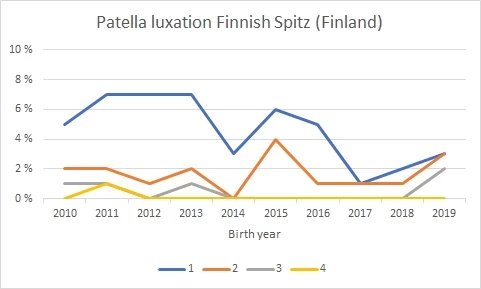
Veterinary eye examination – Finland mandatory (PEVISA) and Norway recommended for Finnish Spitz dogs in order to get their offspring registered or approved by the breed club. Finland: Hereditary cataract, PRA, or PHTVL/PHPV (grades 2-6) not allowed. If one parent has grade 1 PHTVL/PHPV, the other one should be free of PHTVL/PHPV. Eye examinations of the Finnish Spitz dogs are not yet common in Sweden.
Prevalence notes: Eye diseases
The most common eye diseases in the breed are different cataracts as well as PHTVL/PHPV. During the 2010s, cataracts have been found in approximately 5% and PHTVL/PHPV (grades 2-6) in approximately 2.5 % of the dogs examined in Finland. The yearly proportion of examined dogs varies between 25-35 % of all registered dogs. In Norway, out of 13 individuals examined during 2020, 5 dogs were diagnosed with hereditary cataract.
Strategies for Other Conditions
Missing teeth
All Nordic breed clubs are gathering info on tooth problems in individual dogs. The recommendation is to use dogs with only mild teeth problems for breeding and to mate them with a partner, which has a full set of teeth.
Prevalence notes: 14,8 % of the dogs had one or several missing teeth (2019 health survey of the Finnish Kennel Club). Most commonly, 1-3 premolars (P2 and P3) were missing, but several missing teeth were also reported, including molars.
Epilepsy
Breed clubs in Finland, Sweden and Norway collaborate in reporting epilepsy cases and by this, contributing to the estimation of so called epilepsy index for the dogs in the breed. The index is based on the information of epileptic relatives in each dog’s pedigree. In Finland, epileptic dogs are recorded in an open database where epi-indexes are included in the pedigrees, together with notations explaining which relatives account for the index.
Epi-index is calculated from a five-generation pedigree, taking into account the genetic relationships between the dog and its epileptic ancestors. The index has been an effective tool in breeding: strong improvement can be seen starting from the year 2001, when the breeding advisors of the association started to use the indexes.
Prevalence notes: Finland – the frequency of epilepsy has fallen down from the early 2000s’ 5-6 %. Currently, the breed club doesn’t publish the numbers anymore, but keeps a close eye on the situation. Sweden – the last two cases so far were reported in 2016. Data for 2006-2011 and 2011-2016 show that compared to all breeds, Finnish Spitz has a smaller risk for epilepsy.
The management to reduce the incidence of epilepsy in Finnish Spitz is quite well done for a breed which formerly used to be one of the typical epileptic breeds!
About epilepsy seizures in Finnish Spitz: On average, epileptic Finnish Spitz dogs suffer their first seizures at the age of three, get on average three seizures per year and the typical length of a seizure is 12 minutes. Partial seizures, which are commonly associated with behavioural changes and autonomous symptoms like vomiting and drooling, are typical for the breed. More frequent occurrence of seizures can indicate progression of epilepsy, although the course of epilepsy is usually benign.
Reproduction

See more on Reproduction matters under the Genetic Diversity Section below.
Longevity
In the Finnish Kennel Club breeding database the average life span (of the dogs which have been reported as dead during 2011-2021) of the Finnish Spitz is 11 years 3 months. Dogs, whose cause of death was reported to be an old age, had an average lifespan of 13 years and 6 months (see the table below). Typical for a hunting dog is that quite many (99) dogs died in an accident. These accidents include the disappearance of the dog, as well as hitting by a car or other vehicle, as can be seen from the Agria data below.

DNA Tests for Finnish Spitz
At this time there are no relevant Genetic Disease/Disorder DNA Tests for the Finnish Spitz. A few ‘Trait’ and Parentage tests may be relevant.
Genetic Diversity in the Finnish Spitz
To widen the gene pool, the cross-border Russian population that is, according to local estimates, growing strongly, was added to the Finnish Spitz population in 2006.
According to the research by Kumpulainen et al. (2017), the genetic diversity of the Finnish Spitz is still low: “We found that the Finnish Spitz has undergone repeated male bottlenecks resulting in dramatic loss of genetic diversity, reflected by 20 effective founders (fa) and mean heterozygosity (Hz) of 0.313. The realized effective population size in the breed based on pedigree analysis () is 168, whereas the genetic effective population size (Neg) computed the decay of linkage disequilibrium (r2) is only 57 individuals.”
The ratio of sires and dams has increased during the 2000th century both in Finland and Sweden. It is slowly approaching the (usually theoretical) optimal situation where the numbers of breeding males and females are equal. Positive trend indicates better utilization of male dogs and reduced risks of “matador breeding”. Having a ratio as equal as possible is one of the best ways to maintain genetic diversity in a closed gene pool.

Inbreeding affects reproduction as was mentioned earlier. Both in Finland and Sweden the average (short term) inbreeding coefficient is decreasing, and at the same time the average litter size is growing. Increasing genetic diversity will likely have positive effects to all reproduction traits of the breed.
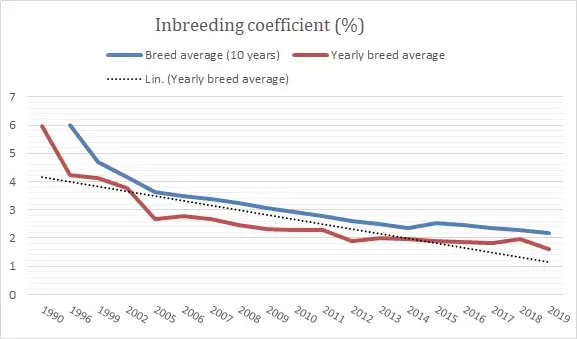

Sweden: (Inavelsgrad = inbreeding coefficient; kullstorlek = litter size; Antal valpar/procent = Number of puppies/percent; genomsnitt = on average; Linjär = trend)
Genetic Diversity Notes: The Nordic breed clubs have worked effectively for years to widen the gene pool of the breed. They have introduced maximum limits for the numbers of offspring per individual dogs as well as for the inbreeding coefficient of the litters. They have also encouraged owners to use their dogs for breeding and thus to increase the number of breeding dogs in the breed.
From the beginning of 2009, at most 70 offspring could be registered in Finland for an individual dog in this breed. The number of registrable offspring was lowered to 50 as of the beginning of 2016. In Sweden, the maximum recommended number of offspring is set at maximum 20% (preferably not more than 10%) of the number of all registered Finnish Spitz puppies per year, and in Norway, 5% of the number of registered Finnish Spitz puppies per 5 years. This is to avoid popular sires and their shrinking effect to the gene pool.
A maximum limit is set also to the inbreeding coefficient of litters. In Finland and Sweden, the limit is 6.25% (calculated from 7 generations in Finland and 5 generations in Sweden) and in Norway 4%. In Finland litters with higher inbreeding coefficient will not be registered at all (PEVISA). In Sweden and Norway the limit is a recommendation.
The Swedish breed club has a system for broadening the gene pool by introducing more male dogs in breeding. They have a list of males which meet the requirements regarding health, hunting traits and exterior. To allow for more diverse use of males in breeding, they have an additional list with the same requirements, except for hunting and show merit. These dogs may be used for 1-2 matings. After 1-2 litters they should have at least a 2nd prize on hunting trials, to be able to sire more litters.
Examples of additional recommendations
Dogs that suffer from a clear sound phobia or are vicious must not be used for breeding.
Neither diabetic nor dogs that produce diabetic offspring should be used for breeding. Nor should two such lines be combined, both of which are known to have diabetic dogs.
Dogs aged under four years are recommended to have at most two litters, and dogs under two years are not yet recommended for breeding. Also bitches are recommended to reach an age of two years before the first litter (Finnish breed club).
- Dogs that suffer from a clear sound phobia or are vicious must not be used for breeding.
- Neither diabetic nor dogs that produce diabetic offspring should be used for breeding. Nor should two such lines be combined, both of which are known to have diabetic dogs.
- Dogs aged under four years are recommended to have at most two litters, and dogs under two years are not yet recommended for breeding. Also bitches are recommended to reach an age of two years before the first litter (Finnish breed club).
Many thanks to Katariina Mäki for pulling together the content presented in this Finnish Spitz GRIHP article.
For the full article, data, references and additional resources see:
dogwellnet.com/content/health-and-breeding/breeds/breed-specific-health-reports
Get a GRIHP! on Finnish Spitz

Simple Ways to Help Your Finnish Spitz Lose Some Weight
Obesity can be a real problem for Finnish Spitzes. An overweight dog has an elevated risk of injury, illness and disease, including Patellar Luxation and Hip Dysplasia. So, it’s important to monitor your dog weight and if needed, to take action to help him become healthier by losing those extra pounds.
The good news is, the process of helping your dog is not really complicated or difficult.
Part of the solution is to learn to Body Condition Score your dog
Here is a chart based on Dr. Sophia Yin’s work and the Nestle Purina’s Body Condition Score system developed in 1997. Thanks to it, you will be able to Body Condition Score (BCS) your Finnish Spitz and learn if he has some weight to lose.

Dogs who are a body condition score of 1 are way too thin—generally truly starving due to illness or poverty. They look like walking skeletons because their poor nutrition has lead to muscle wasting in addition to the loss of fat.
On the opposite end of the spectrum is the body condition score of 5. This is the dog that looks like a giant, overstuffed sausage. He has huge fat deposits over the chest, spine and base of the tail such that his back resembles a table top rather than a living animal. He also has obvious abdominal distension due to fat in the abdomen.
The ideal dog is 3. Dogs with a body condition score of 3 have ribs and vertebrae that you can easily feel. You can see a waist right behind the ribs when viewing from the top, and from the side you can see the abdomen tucks up.
It’s pretty straightforward if your Finkie is out of coat and you go based on the chart included above. But if in doubt, your veterinarian should be able to help you.
Is Your Finnish Spitz Overweight? Here are simple ways to help your dog lose some weight
- Feed a high-quality dog food :
We are not going to get into the debate about whether kibble, canned, home-cooked or raw-food diets are best, but you should avoid cheap dog food brands that are high in corn or other grains and choose brands that have a high meat content (with no by-products). The Dog Food Advisor website is a good resource for checking and comparing different brands of dog food or you can also refer to your veterinarian for suggestions. - Understand feeding recommendations :
Don’t assume the feeding instructions on the packaging of your dog’s food apply to every dog. Finnish Spitzes are called ”easy keepers” since they can maintain a high energy level with a small amount of food. Usually, an adult Finnish Spitz will be satisfied with as little as 1 cup of kibbles per day. So, if your Finnish Spitz is gaining weight and you’re not overfeeding with treats or other food, gradually cut back on the amount of food you are giving him each day. - Measure your dog’s food :
Use a measuring cup to carefully measure each feeding. It’s an easy way to know exactly how much food your dog is eating at each meal and to make gradual adjustments if needed. - Weigh your dog regularly :
According to his standard, an adult Finnish Spitz weight should range between 31 to 35lbs for a male and 22 to 29 lbs for a female. So keep those weights in mind and if you need to adjust his food ratio, monitor your Finnish Spitz weight loss at least once a week. The goal when losing weight should be for your dog to lose about 1% of his body weight per week until he reaches his ideal body weight. - Manage your dog’s hunger :
Your Finnish Spitz might be a little hungry while he’s losing weight. If you normally feed once a day, try breaking the meal into two or three feedings throughout the day. You can also set aside a little of your dog’s daily food portion to use in a treat dispensing toy for later in the evening. You can also add some canned pumpkin or green beans, which are low-calorie fillers, to help your dog feel full during his new diet. - Increase his daly exercise :
Small increases in exercise can make a big difference. Make your daily walk just a bit longer or incorporate more play time into each day. Just like with your dog’s diet, you’ll want to make gradual changes so you don’t overwork your dog, especially if he’s very overweight or out of shape. - Reduce, or eliminate, unhealthy treats :
Have you ever given your Finnish Spitz a large treat or piece of food that he swallowed instantly? Dogs don’t really notice how big a treat is, they’re just happy to get one.
Small, low-calorie training treats are perfect for rewards or simply break bigger treats into small pieces. Your dog will be just as satisfied and you’ll be feeding him fewer calories each time.Try some healthier treats. Many dog treats found in pet stores are high in calories and carbohydrates. You can almost eliminate your dog’s treat calories by replacing them with much healthier snacks. Skip the hot dogs, cheese and peanut butter and see if your dog likes fresh fruits or vegetables. Celery, baby carrots, green beans, broccoli, cucumber slices and apple slices (take out any seeds first) are all great options. You can also put some of your dog’s daily kibble allowance in a container and use this as a treat throughout the day.
Just make sure you’re familiar with foods you shouldn’t feed your dog before feeding any human foods and remember that treats should make up no more than 10% of your dog’s total daily diet.Use different rewards. Using food to motivate or reward a dog works pretty well but we tend to forget that many dogs would be just as happy with a good belly rub or a play session for a reward. Try mixing it up to see if your dog will respond to other things rather than always relying on a food-based reward.
- Have your dog work for food :
Food dispensing balls and puzzles are a good way for your dog to burn off excess energy and calories by working for his food or treats. Most dogs learn quickly how the puzzles or balls work and they enjoy the challenge. - Watch for exta food :
Make sure all family members are cooperating with your goal to make your pup healthier. If some members of the family are sneaking bites of food to the dog (like leftovers during diner time, or some extra treats), all those little bites can add up to a lot of calories. Also, make sure your dog’s not sabotaging his own diet by sneaking food from other sources, like the cat’s food bowl.
If your Finnish Spitz looking a little chubby these days, I hope you will find those tips helpful. Please note that there are some medical reasons your dog could be gaining weight, so it’s important to talk to your vet if you have any concerns about your dog’s weight or nutritional needs.
https://drsophiayin.com/blog/entry/is-your-dog-fit-or-fat-learn-how-to-body-condition-score-him/
Thank you to http://colorsbreedsfpaw.blogspot.com for the original drawing
The Elizabethan collar
An Elizabethan collar, E collar for short or pet cone (sometimes humorously called a pet lamp-shade, pet radar dish, or cone of shame) is a protective medical device placed around the head to prevent an animal from licking or biting at a surgery site, wound, or bandage.
It is a very useful tool after surgery, such as spaying or neutering. It is natural for a dog to lick his wounds, but this can seriously delay healing and result in infection or injury. So it is important that a protective collar is used, especially when the dog is unattended and could inadvertently injure himself.

I did photograph the experience with Kaori who never had to wear an Elizabethan collar before. Most Finnish Spitzes are food motivated like mine. It makes things far easier for us and for them!
Teaching your dog to love the cone
By Sandra Robbins BS, CVT, VTS (Anesthesia & Analgesia), CPDT-KSA, KPA-CTP
Date Published: 01/10/2022
Elizabethan collars (sometimes referred to as “cones
of shame”) are necessary tools to keep pets from
licking a surgical site, wound, or hot spot; chewing off
bandages or splints; or scratching their ears or face.
By desensitizing your dog to wearing a cone, it will
be less stressful for your pet if and when they need
to use one. Several types of cones are available, some
of which are more comfortable for the animal.
The method detailed below is illustrated with a clear
plastic cone and a dog but it works for all types of
cones and applies to both dogs and cats.
Getting your pet used to the cone:
Desensitization is only effective if your pet remains
calm. If your pet becomes distressed, you will need to
find a way to make the training easier.
STEP 1- INTRODUCTION
• Leave the cone assembled in a corner of a familiar
room
• Place it wide part down so that it is least likely to
move
• Put treats around the outer rim of the collar
• Once a day, check on the cone and put out new
treats, if your dog ate the previous treats
• If your pet is comfortable approaching the cone for
treats, proceed to the next step
STEP 2- INTERACTION
• Lay the cone on its side
• Put treats in and around the cone
• Encourage your dog to approach and get treats from
the cone
• Your dog should see this as a game and want to
move the cone for the treats
• Repeat as necessary to increase your dog’s comfort
with the cone
STEP 3- HOLD THE CONE
• Encourage your dog to approach you while you hold
the cone
• Choose to feed with either the hand holding the
cone or the free hand based on your dog’s comfort
• Gradually work on getting your dog to approach the
narrow opening and eat treats held in a hand in the
cone
• Start with a hand in the cone, eventually moving the
hand away from the narrow opening so your dog has
to place its head through the narrow opening of the
cone to eat the treats
• For dogs who are afraid of the cone while it is in
your hand, back up to step two or try leaving it on the
floor and steadying it with your hand so they can
approach it and eat the treats. You could also try
using a higher value treat.
• Repeat this step, only if your dog is eagerly
participating
STEP 4- HEAD IN THE CONE
• Hold the cone as in step 3
• Have your treat hand inside the cone far enough
away from the narrow opening that your dog has to
put its head all the way through the narrow opening
to get the treats
• Hold the cone so your dog can back out comfortably
without the collar getting stuck on its head
• Repeat this step encouraging your dog to slip its
head in and out of the cone with ease
STEP 5- WEARING THE CONE
• Repeat the process from step 4, but this time allow
the cone to rest on your dog’s neck and feed treats
– If your dog is comfortable, feed treats
– If not, help them out of the cone and then back up
to an easier step
• If they can keep the cone on, encourage your dog to
walk to get a treat
• Repeat this process so that your dog can feel
comfortable wearing the cone and walking around the
house


TREATS AROUND THE CONE


TREATS IN THE CONE

THIS IS CLEARLY A FUN GAME
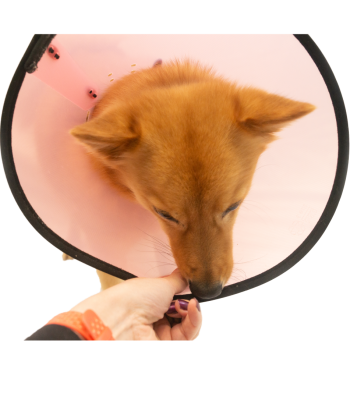
LURE INTO THE CONE WITH TREATS








